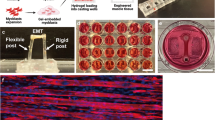Summary
Cell culture models that mimic long-term exposure to microgravity provide important insights into the cellular biological adaptations of human skeletal muscle to long-term residence in space. We developed insert scaffolding for the NASA-designed rotating cell culture system (RCCS) in order to study the effects of time-averaged microgravity on the proliferation and differentiation of anchorage-dependent skeletal muscle myocytes. We hypothesized that prolonged microgravity exposure would result in the retardation of myocyte differentiation. Microgravity exposure in the RCCS resulted in increased cellular proliferation. Despite shifting to media conditions promoting cellular differentiation, 5 d later, there was an increase in cell number of approximately 62%, increases in total cellular protein (52%), and cellular proliferating cell nuclear antigen (PCNA) content (2.7 times control), and only a modest (insignificant) decrease (10%) in sarcomeric myosin protein expression. We grew cells in an inverted orientation on membrane inserts. Changes in cell number and PCNA content were the converse to those observed for cells in the RCCS. We also grew cells on inserts at unit gravity with constant mixing. Mixing accounted for part, but not all, of the effects of microgravity exposure on skeletal muscle cell cultures (53% of the RCCS effect on PCNA at 4–6 d). In summary, the mechanical effects of simulated microgravity exposure in the RCCS resulted in the maintenance of cellular proliferation, manifested as increases in cell number and expression of PCNA relative to control conditions, with only a modest reciprocal inhibition of cellular differentiation. Therefore, this model provides conditions wherein cellular differentiation and proliferation appear to be uncoupled.
Similar content being viewed by others
References
Baldwin, K. M. Effect of spaceflight on the functional, biochemical, and metabolic properties of skeletal muscle. Med. Sci. Sports Exerc. 28:983–987; 1996.
Bird, R. B.; Stewart, W. E.; Lightfoot, E. N. Transport phenomena, New York: Wiley; 1990.
Bischoff, R. Control of satellite cell proliferation. In: Griggs, R.; Karpati, G., ed. Myoblast transfer therapy. New York: Plenum Press; 1990:147–158.
Blau, H. M.; Pavlath, G. K.; Hardeman, E. C., et al. Plasticity of the differentiated state. Science 230:758–766; 1985.
Florini, J. R.; Ewton, D. Z.; Magri, K. A. Hormones, growth factors, and myogenic differentiation. Annu. Rev. Physiol. 53:201–216; 1991.
Kulesh, D. A.; Anderson, L. H.; Wilson, B., et al. Space shuttle flight (STS-45) of L8 myoblast cells results in the isolation of a nonfusing cell line variant. J. Cell. Biochem. 55:530–544; 1994.
Molnar, G.; Schroedl, N. A.; Gonda, S. R., et al. Skeletal muscle satellite cells cultured in simulated microgravity. In Vitro Cell. Dev. Biol. 33:386–391; 1997.
Rabin, R.; Gordon, S. L.; Lymn, R. W., et al. Effects of spaceflight on the musculoskeletal system: NIH and NASA future directions. FASEB J. 7:396–398; 1993.
Schwarz, R. P.; Goodwin, T. J.; Wolf, D. A. Cell culture for three-dimensional modeling in rotating-wall vessels: an application of simulated microgravity. J. Tissue Cult. Methods 14:51–58; 1992.
Taylor, D. A.; Atkins, B. Z.; Hunspreugs, P., et al. Regenerating functional myocardium: improved performance after skeletal myoblast transplantation. Nat. Med. 4(8):929–933; 1998.
Torgan, C. E.; Burge, S. S.; Collinsworth, A. M., et al. Differentiation of mammalian skeletal muscle cells cultured on microcarrier bead in a rotating cell culture system. Mol. Biol. Eng. Comput., 38(Cell. Engin.): 583–590; 2000.
Wolf, D. A.; Schwarz, R. P. Analysis of gravity-induced particle motion and fluid perfusion flow in the NASA-designed rotating zero-head-space tissue culture vessel. NASA Technical Paper 3143; 1991.
Wolf, D. A.; Schwarz, R. P. Experimental measurement of the orbital paths of particles sedimenting within a rotating viscous fluid as influenced by gravity. NASA Technical Paper 3200; 1992.
Yaffe, D.; Saxel, O. Serial passaging and differentiation of myogenic cells isolated from dystrophic mouse muscle. Nature 270:725–727; 1977.
Author information
Authors and Affiliations
Corresponding author
Rights and permissions
About this article
Cite this article
Slentz, D.H., Truskey, G.A. & Kraus, W.E. Effects of chronic exposure to simulated microgravity on skeletal muscle cell proliferation and differentiation. In Vitro Cell.Dev.Biol.-Animal 37, 148–156 (2001). https://doi.org/10.1290/1071-2690(2001)037<0148:EOCETS>2.0.CO;2
Issue Date:
DOI: https://doi.org/10.1290/1071-2690(2001)037<0148:EOCETS>2.0.CO;2




